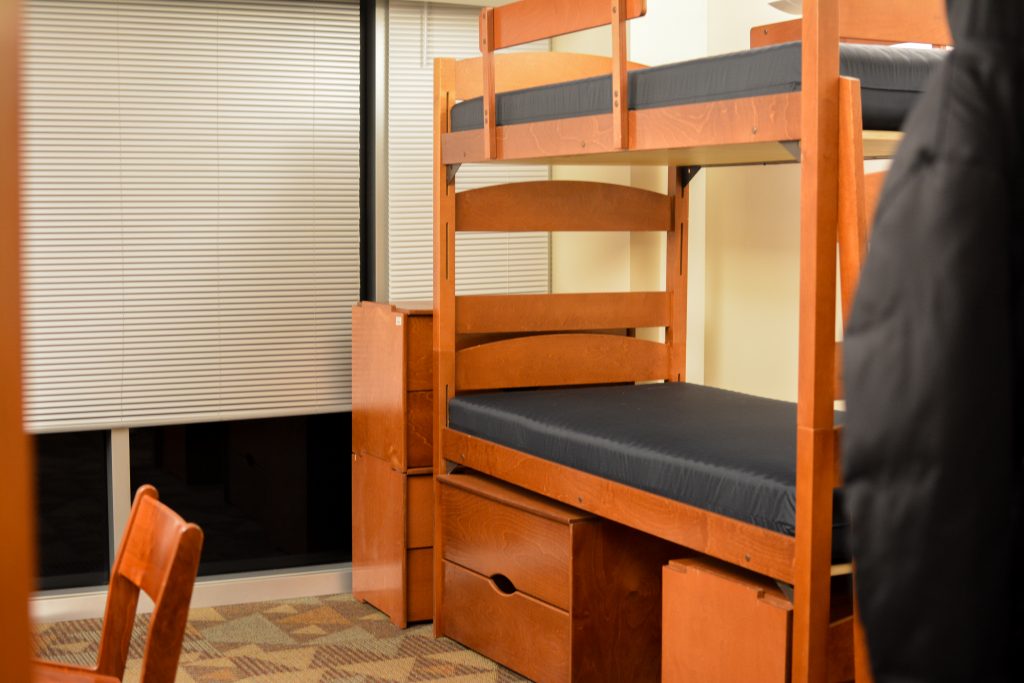
At Binghamton University, 28 students have spent their first weeks of classes living in converted lounges located in Hinman and Newing Colleges.
The temporary living situation was implemented to accommodate an overflow of transfer students and spring admits. Depending on the size and configurations of the lounges, each temporary dorm houses four to six students. There are currently 11 students who are still waiting to be relocated to permanent housing, and seven in the process of relocating.
According to Paola Mignone, the interim director of Residential Life, while BU admits new students every semester, more students committed to the University than in previous years. According to Ryan Yarosh, senior director of media and public relations at BU, enrollment numbers have increased by around 300 students since last year, with almost 17,800 undergraduate and graduate students currently enrolled.
“More and more students are interested in Binghamton and with that comes an influx of students who want to live on campus,” Yarosh wrote in an email. “It’s not uncommon to start the semester with slightly more students than we can accommodate and I commend the [Residential] Life team for coming up with a creative solution.”
It is not the first time the University has grappled with overcrowding. In fall 2017, approximately 200 students were housed in forced triples at the beginning of the year, and in fall 2016, roughly 160 students found themselves living in temporary housing with an extra roommate. For this semester, ResLife decided to convert two lounges in Hinman College and three lounges in Newing College into temporary dorm rooms, rather than making existing rooms into triples, as BU has done in the past.
According to Mignone, students are receiving a discount for the number of days they’re in temporary housing.
“Relocating students out of temporary spaces and into more permanent spaces is a priority,” Mignone wrote in an email. “We are working quickly and diligently to offer students a permanent room to move to as spaces become available.”
Students such as Anna Siu, an undeclared freshman temporarily living in a lounge in Bingham Hall of Newing College, have posted signs to their doors to indicate the rooms are dorms to prevent residents from walking in. For these students, the only way to get out of temporary housing is to find and take an open spot in a dorm, which can be located in any of the seven housing communities on campus. Siu said students were allowed to turn down a room option if it wasn’t in a living community they wanted, but had to take the second option ResLife offered, leaving them few options if the room was in an undesirable location, living arrangement or living community.
“We were pretty pissed about that because we weren’t given the option to stay here as temporary housing,” Siu said. “We thought they were going to give us more options and the right to choose the room we wanted. I thought we could choose but we couldn’t.”
Siu, who is being relocated to Dickinson Community, said she’s annoyed she will have to move a second time.
“At first, we were like, ‘Why don’t we just stay in this room since everyone was already moved in here?’” Siu said. “We don’t want to move to a different place because it’s such a difficult process.”
Hannah Loffman, a junior majoring in human development and a resident of Bingham Hall, said ResLife did not inform permanent residents of the building about the temporary housing situation. Loffman said she believes the temporary living situation takes away from the communal aspect of living communities.
“I just know for myself, I wouldn’t have wanted to come to college and be stuck in this awkward situation of using the public restroom or needing to share a bathroom with six other people and to have taken away from students’ study spaces,” Loffman said.
Residents living in the temporary housing were informed of the living situation prior to the start of the semester. However, Emma Roy, a junior majoring in accounting and living in temporary housing in Bingham Hall, said she wasn’t sure what to expect when she moved into her temporary home, despite the notification.
“It was mostly just like, ‘Well, we don’t have enough space for you so we have a converted lounge,’” Roy said. “There were no pictures of it or reference of it. All we were told is that we’d get a desk, a wardrobe and everything.”
Lia Berger contributed reporting to this article.


